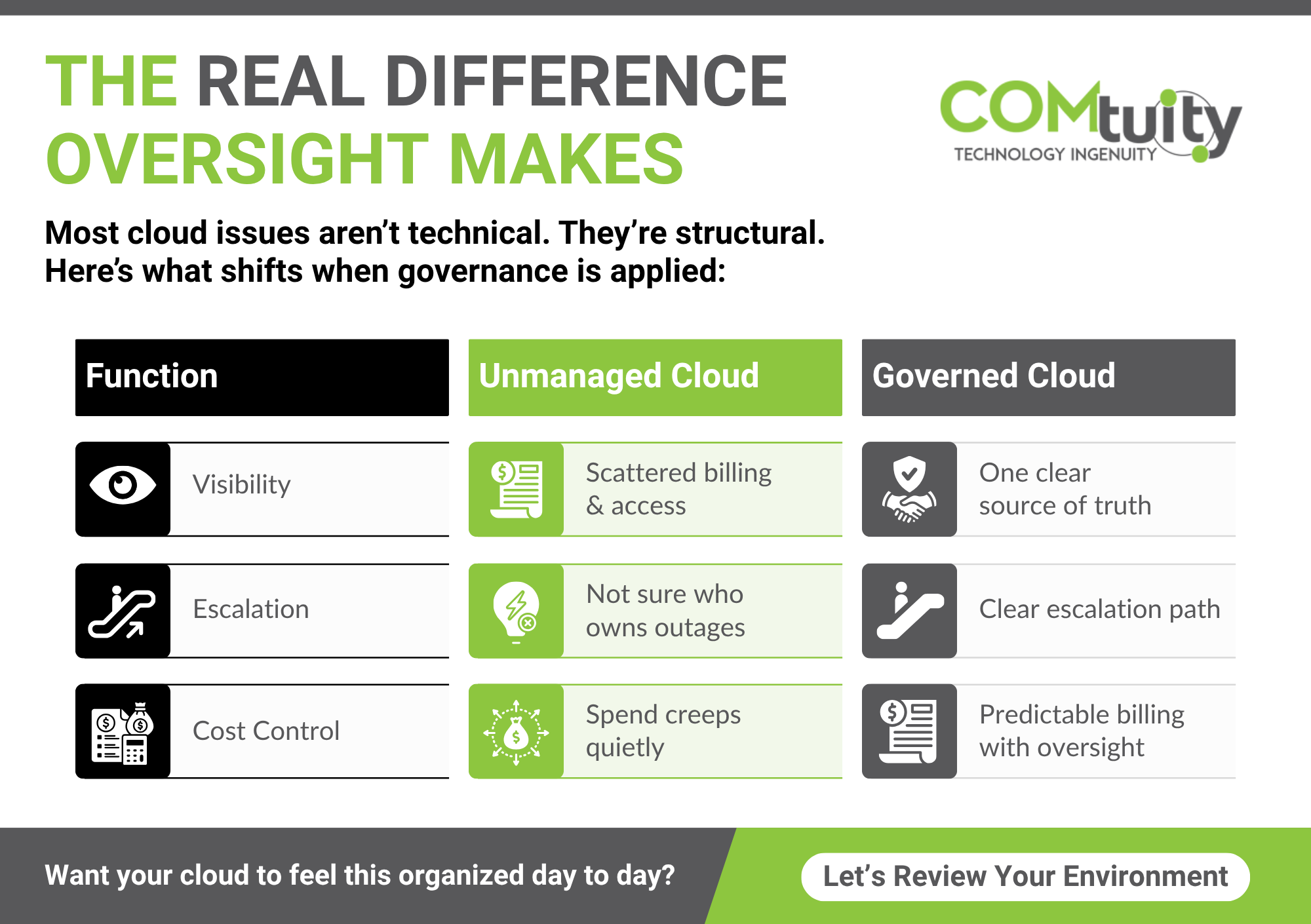Cloud tools were supposed to simplify business. Shared data, flexible access, better collaboration. For many organizations, especially those with multiple sites, the reality feels more scattered than streamlined. Instead of one reliable system, there are dozens of platforms managed in different ways by different teams. Costs rise without a clear explanation. Leaders lose sight of what is connected to what, and confidence fades just as quickly as visibility.
According to Flexera’s 2025 State of the Cloud Report, 84% of businesses still struggle with cost control and visibility. After years of cloud adoption, most organizations are not lacking technology. They are lacking clarity.
That is because cloud optimization is not a technology challenge. It is a management challenge. Without clear ownership and consistent oversight, even the best tools turn into a maze of subscriptions, renewals, and workarounds that make daily operations harder instead of easier.
Quick Gut Check: Before we go any further, see how your own environment stacks up.
You do not need to understand every technical detail to know if your cloud is working for you. What you need is visibility into what exists, ownership of who is responsible, and consistency in how it is managed. These are leadership practices, not infrastructure features.
COMtuity partners with business owners to build that structure so technology becomes a source of confidence, not confusion.
Why “Cloud Sprawl” Happens in Growing Businesses
Every growing organization experiences a moment when its technology environment stops feeling connected. It’s not a single failure. It’s an accumulation of well-intentioned choices that slowly move in different directions.
One team adds a project management app. Another subscribes to a new data tool. Someone opens a cloud storage account “just for now.” Over time, each decision makes sense in isolation. But together, they create overlap and confusion.
This is what cloud sprawl looks like:
- Dozens of apps solving the same problem in different ways.
- Multiple logins for tools that could be centralized.
- Licenses renewed automatically without review.
- Little clarity on who owns what or how systems connect.
For businesses with multiple sites, the impact easily multiplies. Each branch or region builds its own setup, using the tools that feel most convenient. What emerges is not one organized environment but a patchwork of systems.
It’s not a sign of poor IT leadership. It’s what happens when growth outpaces structure. Internal teams are focused on keeping operations running, not auditing every subscription or access rule. Over time, that lack of visibility turns into higher costs, slower response times, and growing security risk.
But you don’t have to start everything over. You just need to bring structure to what you already have.
What Leaders Should Really Be Asking About Cloud Health
Leaders don’t need to know every technical detail to understand if their cloud environment is healthy. What matters is having visibility into how systems work together and how decisions are made. The best way to assess that is by asking questions that expose gaps in structure, accountability, and control. Start by asking your team the following questions.
- Do we have one clear view of all cloud usage, cost, and performance across every location? If you need multiple reports or separate logins just to see what you’re paying for, the environment isn’t being managed as one system.
- Who owns each platform, and how is accountability maintained? Clear ownership prevents duplication and ensures that every tool supports a defined purpose.
- When something breaks, do we know who resolves it and how quickly it happens? If resolution depends on who you ask or where the issue occurs, accountability is fragmented.
- Are permissions, access levels, and security policies consistent across all teams? When access rules differ between departments, security risks and compliance gaps increase.
- Do we have a process for reviewing and removing old accounts, unused licenses, or duplicate tools? Inactive users and forgotten subscriptions can quietly drain budgets and expose old credentials to risk.
- Are updates, renewals, and system changes tracked and documented in one central location? When records are scattered, even simple changes can lead to confusion or downtime.
These questions aren’t about technology; they’re about clarity. A healthy cloud environment should be transparent, predictable, and consistent across every location.
If those questions were difficult to answer confidently,
feel free to use this quick scorecard to map where structure is missing.
When leaders can’t answer these questions easily, it’s not a sign of failure but a sign that systems have grown faster than structure. And ultimately, your cloud management may need outside management to help keep it organized.
Structure Before Spend: The Foundation of Cloud Optimization
When businesses talk about cloud optimization, the conversation often starts with cutting costs. But cost shouldn’t be the starting point, but the outcome. The real foundation of optimization is structure. Without structure, cost management is a guessing game, and you can’t reduce what you can’t see.
For example, imagine two departments using different file-sharing platforms. Both systems work fine until one site can’t access shared files, or security settings don’t match. The problem isn’t the platform itself; it’s the lack of alignment.
When structure comes first, efficiency follows. Teams stop buying duplicate tools. Security becomes easier to enforce. Support issues are resolved faster because roles and systems are clearly defined.
It’s not hard to understand, but can be hard to maintain. Most internal teams know what “good” infrastructure looks like. They don’t have the time or bandwidth to enforce it across every tool, process, and location. That is where outside guidance begins to make a difference.
The Role of a Tech Advisor in Bringing Order and Clarity
Expecting your internal team to manage every aspect of cloud operations isn’t realistic. Lean IT teams already handle support tickets, vendor coordination, and daily requests while trying to keep everything running smoothly.
At COMtuity, we don’t replace your team’s expertise; we channel it. As your strategic IT advisor, we can connect your business and technology sides of cloud management, helping you align decisions with long-term goals instead of reacting to short-term challenges.
In practice, that looks like:
- One place to see vendors, contracts, usage, and billing
- One process for onboarding, access, renewals, and escalations
- One standard for monitoring performance and resolving issues
- One lifecycle rhythm for reviewing old accounts and removing waste
These are not flashy upgrades. They are quiet, behind-the-scenes business stabilizers. When every part of your cloud has an owner and every process has a place, daily operations stop feeling unpredictable.
Leaders can make decisions based on facts instead of assumptions, and teams respond faster because expectations are consistent across every location.
Why Structure Slips Quietly Without Oversight
If some locations operate differently from others, your cloud will behave the same way. When no one protects alignment, drift happens by default. That is not a technical failure. It is the result of decisions stacking without a common framework.
Most leaders recognize their business in one of those columns immediately. The goal is not perfection, but predictability. Structure only holds when someone actively maintains it.
How COMtuity Helps Maintain Cloud Strategy
That’s where COMtuity helps.
We partner with multi-location businesses that have outgrown their original IT setup. Our role isn’t to sell new platforms but to organize what’s already there and keep it working together.
We connect the moving parts: vendors, contracts, tools, and policies into a cohesive system. We apply consistent standards across every location, so leaders always know where things stand. And we stay involved, making sure decisions remain aligned as the business scales.
Because COMtuity operates as an independent advisor, we are not tied to any one vendor or provider. That means the guidance you receive centers on what serves your goals best, not what sells best.
When cloud systems are managed with that kind of consistency, leaders don’t have to chase information or second-guess decisions. They have a partner maintaining structure behind the scenes, keeping operations smooth and accountable over time.
Ready to bring clarity back to your cloud? Contact us today! Let’s talk about how COMtuity can help you turn complexity into control.





